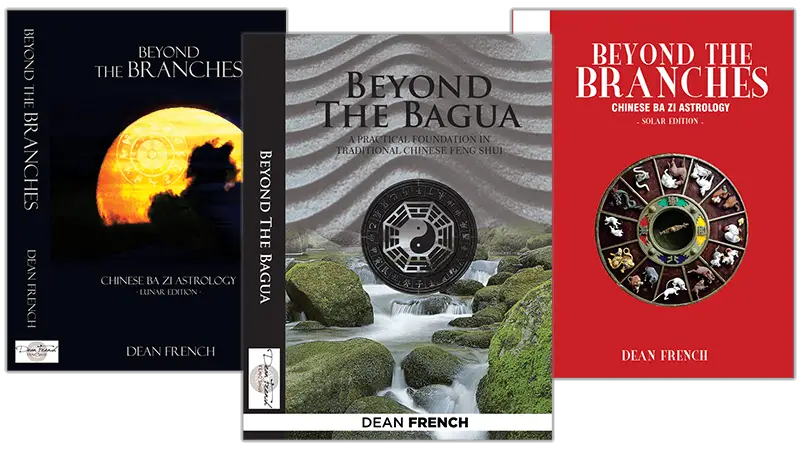What are the Feng Shui Flying Stars?
When you are searching for a place to live, it can be helpful to learn about the Xuan Kong Flying Stars.
This Feng Shui practice assigns numbers to different parts of the home or office based on the facing direction (in degrees) and the year the home was built.
There are sub-Schools within this overall methodology, some using move-in date rather than building completion date and others using Xuan Kong Da Gua period timing to catch the oncoming Chi. In this article you will learn the standard Xuan Kong Fei Xing method of traditional Feng Shui, read on to find out more.
What Does a Flying Stars chart look like?
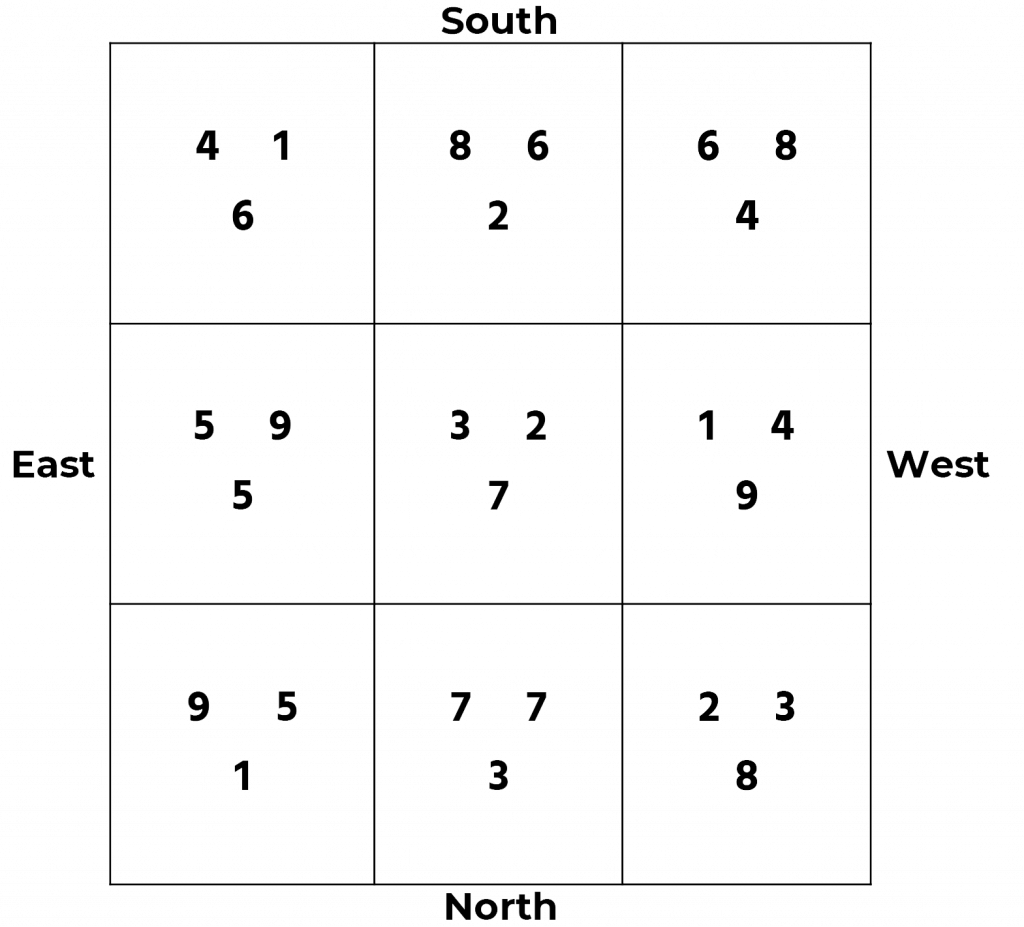
The numbers you see in a Flying Stars chart are more than they appear to be, representing the Trigrams and Ming Gua’s, Form School, Chi flows, BaZi Four Pillars astrology and more.
They can predict the Chi influences on your life and how people perceive you. For example, if your bedroom has out of period star energy, you can have difficulty sleeping at night because the Chi is stale and stagnant. Calculate your Flying Stars chart here.
The Basis of The Flying Star School
In general, when people use the term Flying Stars they are referring to a collection of traditional Feng Shui based numerological methods that have a surface appearance to western-style numerology (or even called Sudoku by some cheeky wags). The initial foundation is the Lo Shu, also known as the Bagua or Later Heaven Arrangement.
From this starting point, the Fei Xing practitioner will build a complex chart using their Luo Pan compass reading to map the Lo Shu numbers to their timely Mountain and Water positions. The Flying Star chart is then overlaid the building Floor Plan and analyzed by the practitioner with the external and internal Landforms and Five Elements taken into consideration.
There are several Flying Star charts that you can cast. The initial building date chart based on the Period of course, then a move-in date chart can be layered to determine if that has had a lasting effect on the occupants.
In addition to the Lo Shu and Period charts, there are annual, monthly and daily stars, as well as the Hou Tian (Early Heaven) Bagua and HeTu diagrams to take into account.
The Lo Shu
According to the Flying Stars (and Ba Zhai, and Nine Star Ki, and many other Feng Shui schools), each of the nine energy stars have characteristics and meanings that follow the sequence of our daily lives. The Lo Shu square is an important factor because it sets the framework and sequence for the stars or numbers to move, or ‘fly’.
I’ve presented the Lo Shu numbers in the Later Heaven Arrangement below with reference to their Trigrams and directions. If you follow the lines connecting the numbers, they show the direction you should follow, no matter which number is in the center. If the number 6 is in the center, the sequence will stay the same and all the numbers and Trigrams will relocate – 7 moves to where the 6 was, 8 moves to where the 7 was etc. If you can memorize the sequence, you will have a great start in Flying Stars Feng Shui.
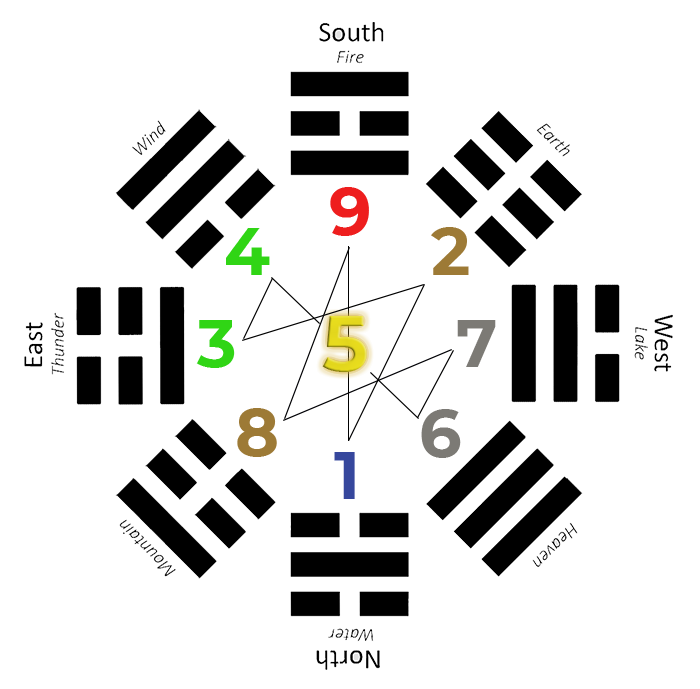
If you’d like to learn more about the individual numbers and their meanings, head over to the full Trigrams article.
The Flying Stars change every single year, which gives practitioners like myself the chance to write really interesting articles. It is important to know the current Annual Chi in your home or office space alongside your building’s Period chart so that you can gain the most most momentum even before the year has begun.
Like this article? Tap to share
Time Periods in Flying Stars Feng Shui
In general (leaving the annuals etc aside for the moment), time in Fei Xing Flying Stars is assessed in 20-year periods, called a Yun as part of an overall 180 year Yuan cycle.
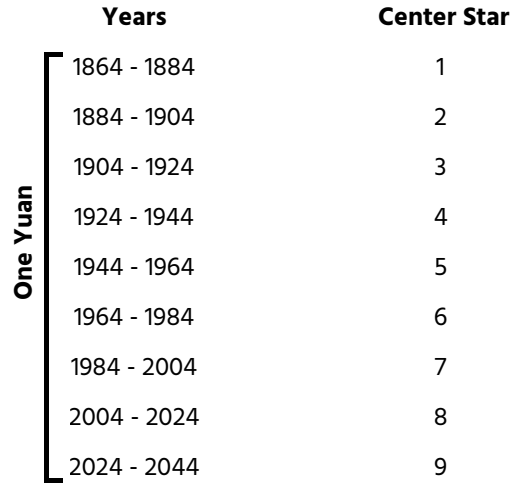
Our current Yun is Age 8 and has the 8 star in the center position. When you ‘fly the stars’ for Period 8, you just put the 8 in place of the 5 in the Lo Shu and then follow the sequence.
You then use the Period/Yun chart above to find out which is the center star for your house. If your house was built in 1954, then the 5 will stay in the center, but if was built in 2001, the 7 star will be in the center.
The only time it gets tricky trying to find the center star is when the Yun changes over. The year changes around the 4th of February every year, so if you think your home was built around 2003/2004 then you will need to do some detective work to find out when the builders started.
Speaking of that, some Masters use ground digging date, while others use the roof completion date. Most of the time it doesn’t matter because 20 years is a big range to work with.
The Concepts of Mountain and Water
The majority of modern day Feng Shui enthusiasts would be aware that it is advisable to have higher ground, or mountain at the back of their houses and lower ground or water at the front. This complies with the basics of Form School Feng Shui but there is a lot more to these concepts in Flying Stars. It is a good idea to become used to the different ways they are used to avoid confusion later on.
- In Xuan Kong Fei Xing, each of the 9 sectors (including the center) has Mountain and Water Stars. Mountain stars relate specifically to human health and relationships, Water stars to wealth and good (or bad) fortune.
- Since Feng Shui is shorthand for ‘Wind carries and disperses Qi, while water retains it’, it is logical that a way to help a home is by blocking directions that bring negative Qi using Mountains, and opening positive Qi directions using Water.
- Mountains can take the form of neighbors houses, sheds, walls, closed doors and windows.
- Areas can hold water Chi by having actual water, or a large amount of open, uncluttered space.
- Mountain and Water landforms can act as activators for the stars. A wall or large item of furniture will act as an activator for a mountain star, and open space or a water feature will activate the water star.
- Do not mix up the term ‘mountain’ as used in landforms with the 24 Mountains, which are specific directions of the compass – the 8 major directions divided into 3 mini-directions each.
The 24 Mountains and Compass Measurements
A compass is an instrument designed to measure direction based on the Earth’s magnetic field. The directions are based on dividing up a circle into 360 degrees (360°). North is both the start and the end, so it is 0° as well as 360°. South is directly opposite North so it is 360/2 = 180°. East is halfway between North and South, so it is 180/2 = 90°. West is directly opposite East, so it is 90+180 = 270°.
There are subdivisions within these four ‘Cardinal’ directions; Northeast (NE) is halfway between North and East, so it is 45° and so on. Being able to accurately measure directions and subdivisions based on a compass reading is extremely important in traditional Feng Shui, so work hard on these concepts and techniques. Read more about the different types of compass on the market as well as the Feng Shui Luo Pan here.
The 24 Mountains are based on dividing the 360 degrees into 24 directions, each of 15 degrees. The 24 Mountains are used mainly to determine the way in which the water and mountain stars will fly in the chart – whether in a Yang (forward) direction, or in a Yin (reverse) direction. The 24 mountains can be used to calculate specific fortune enhancers like Castle Gate, Five Ghosts Carry Money and many others.
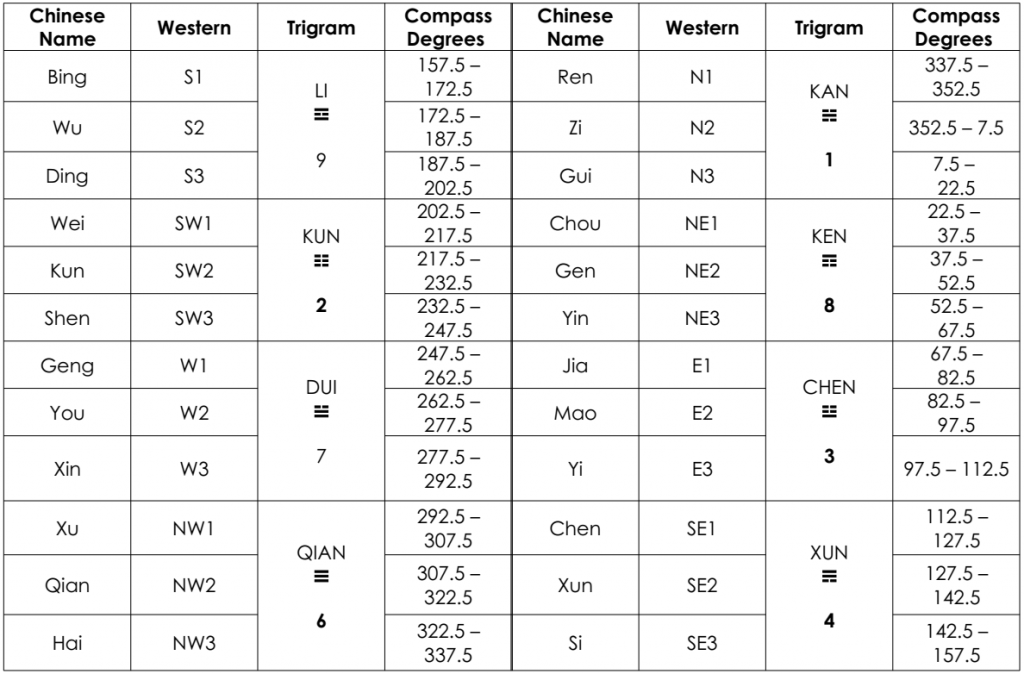
Like this article? Tap to share
There's a whole world of Flying Stars Feng Shui to Learn
The Flying Stars school of Feng Shui can be very useful when trying to harness your homes Chi for a fast improvement in your living conditions. Calculate your own home’s Flying Star chart here.
This article is only a small taste of the concepts you’ll need to understand about the Flying Stars. Make sure that you’re aware of the energies that you’re working with by using an experienced practitioner or taking a course with a trusted teacher.
Flying Star Feng Shui Resources
Learn the Ancient Chinese Arts of Feng Shui, Lunar Chinese Astrology, and Solar Chinese Astrology with Dean’s Comprehensive Bundle!
Get everything you need to start learning these ancient arts in one convenient bundle. This bundle includes detailed course notes and examples covering everything from the basics of Feng Shui to the more advanced concepts of Lunar Chinese Astrology and Solar Chinese Astrology.
They are clear, concise, and easy to follow, especially for beginners. You’ll learn everything you need to know to improve your life with the help of these ancient arts.
Limited time offer: Get a $150 bundle discount ($747 down to $597) when you purchase all three courses today!

